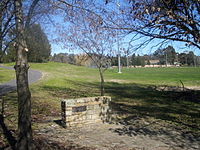Aranda, Australian Capital Territory
| Aranda Canberra, Australian Capital Territory | |||||||||||||||
|---|---|---|---|---|---|---|---|---|---|---|---|---|---|---|---|
 | |||||||||||||||
| Population | 2,412 (2006 census)[1] | ||||||||||||||
| Established | 1967 | ||||||||||||||
| Postcode(s) | 2614 | ||||||||||||||
| District | Belconnen | ||||||||||||||
| Federal division(s) | Fraser | ||||||||||||||
| |||||||||||||||
Aranda is a suburb in the Canberra district of Belconnen. It is the eastern most suburb in Belconnen, located at the western foot of Black Mountain. Bounded on two sides by nature park, the suburb is characterised by its bush setting. During the planning and development of the suburb, a large proportion of large native trees – predominantly eucalypts – were left in place.
The suburb derives its name from the Arrernte tribe of Central Australia, previously known as Arunta, which means 'White Cockatoo'. The streets in Aranda are named after Aboriginal tribal groups from around Australia. The suburb comprises an area of 160ha and in 1967 was the first suburb in Belconnen to be settled. On Census night 2006, Aranda had a population of 2,412 people. [1]
A small plaque at the Aranda District playing fields near the suspension bridge over Belconnen Way marks the settlement of the suburb as the first development in the Belconnen district. It reads:
- "This tablet marks the inauguration of development of the district of Belconnen by the Minister of State for the Interior The Honourable J. D. Anthony, M.P. 23rd June 1966"
Location and transport

Aranda is located in the south east of Belconnen. It is bounded by Caswell Drive on the east, separating the suburb from Black Mountain Nature Park, Belconnen Way to the north, Bindubi Street to the west and Aranda Bushland to the south. A pedestrian bridge crossing the six-lane Belconnen Way connects the suburb with the suburb of Bruce to the north. The suburbs of Cook and Macquarie are located to Aranda’s west on the opposite side of Bindubi Street.
Aranda is located 7km to the west of Civic along Belconnen Way. Bandjalong Crescent, a curved bell shaped street is the main street passing through the suburb, connecting Caswell Drive with Bindubi Street. A number of community facilities are located in the centre of the curve.
A bicycle path along Bindubi Street connects Aranda with the Canberra bike path network. A walking path runs through a reserve along the spine of the suburb and connects with the footbridge to the suburb of Bruce. A walking track over Black Mountain connects Aranda with the CSIRO and the Australian National University.
Aranda is served by buses which connect Civic with Belconnen Town Centre via Cook and Macquarie. Buses to Belconnen also stop on Belconnen Way and at the Calvary Hospital located in Bruce without passing through the suburb.
Facilities

A number of community facilities are located close to one another near the intersections of Bandjalong and Bindel Streets. These include two primary schools (Aranda Primary School and St. Vincent's Catholic school), two churches and a pre-school.
The local shops have been in decline for a number of years and, unlike most other suburbs in Canberra, has not had a general store since the 1980s. The individual shops have been unleased for a number of years and the site, which is in a serious state of disrepair, may be developed in future as apartments. The Jamison Centre in nearby Macquarie services the suburb.
A number of playing fields are located in the north western corner of the suburb including baseball and soccer fields, as is a Scout hall. A nursing home is also located on Bindel Street.
Community activity
Due to its setting in a bush environment and the interest expressed by its residents, Canberra’s first Community Fire Unit was established in Aranda in 2003 [1]. The programme provides Aranda residents with training and fire fighting equipment to fight bushfires in their suburb.
The Friends of Aranda Bushland group is active in the suburb and there is an active Neighbourhood Watch group.
Aranda Residents Group is active in representing the interests of its residents. Between 2000–2005 residents have been vocal opponents on major planning issues including the Gungahlin Drive Extension and the proposed ‘A10’ planning reforms. The Gungahlin Drive Extension, currently under construction,is a four lane road which will connect Gungahlin Drive in Gungahlin with Parkes Way near Lake Burley Griffin. The road will travel along the route of Caswell Drive, a two lane road separating Black Mountain reserve from Aranda and will increase the amount of traffic travelling past the suburb. ‘A10’ is the name of a zoning scheme which would allow the construction of medium density housing in residential areas within close proximity to local shops. Many residents of Aranda are concerned that such developments are inappropriate in quiet streets such as those in their suburbs.
Government
The suburb is located in Federal electorate of Fraser, and the ACT Legislative Assembly Electorate of Ginninderra.
In the 2004 Federal Election the Aranda booth was won by Australian Labor Party with a stronger than average showing for the Australian Greens (House of Representatives Labor 56%, Liberal 25%, Greens 16% [2]; Senate Labor 41%, Liberal 26%, Greens 29% [3]).
Geology
Aranda is built on top of rocks from the Pittman Formation. These are from the upper Ordovician Age. Mostly the rocks are greywacke formed on a continental slope, but also have bands of the Acton Shale Member, a grey to black laminated shale. The Acton Shale contains graptolites. The Deakin Fault cuts through the south west of the Aranda Bushland. South west of the fault is Silurian age Mount Painter Volcanics tuff and ashstone.
Footnotes
- ^ a b Australian Bureau of Statistics (25 October 2007). "Aranda (State Suburb)". 2006 Census QuickStats. Retrieved 2009-03-17.
